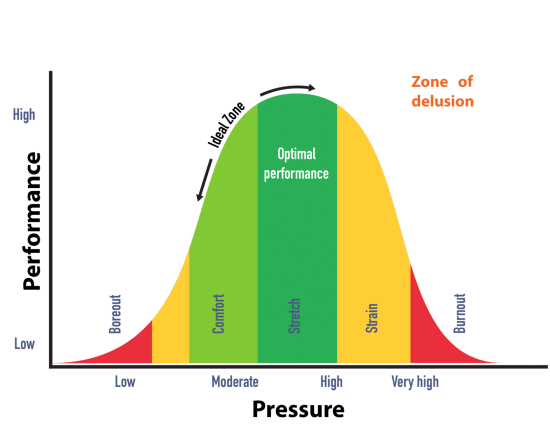
The road out of burnout
by Lisa Chiang
Feeling like you’re running on empty? You’re not alone.
As a mental health practitioner, I understand firsthand the toll of giving so much of ourselves in every interaction, every added ‘yes’ to our plate. Despite our expertise in recognising and addressing burnout in others, we often hold ourselves to superhuman standards. Caught in the whirlwind of busyness, we may overlook the early signs, believing falsely that pushing harder or being more productive will fix everything. It’s what’s called the ‘Zone of Delusion’ on the Yerkes-Dodson stress curve, where we propel ourselves down to burnout by trying harder.

Stress and the pressure performance curve [Digital image]. (n.d.).
Recognising burnout
I came home from work one day and one of my teenage sons presented me with a troubling issue and was seeking my help, advice, and guidance. I almost walked back out the door. This was a pivotal moment of realisation that I poured all of myself into my job which left nothing for the most important people in my life. This recognition sparked a sense of urgency—I knew I had to stop, reflect, and take action before the toll became greater. This marked not the end, but the beginning of the journey on the road out of burnout.
Recognising the early signs of burnout is crucial for taking proactive steps to manage stress and maintain wellbeing. Burnout is a state of emotional, physical, and mental exhaustion caused by prolonged and excessive workplace stress (World Health Organization, 2019). It often arises when we feel overwhelmed, emotionally drained, and unable to meet the constant demands. Here are some early signs to watch out for:
- Emotional exhaustion and fatigue: Feeling drained and worn out, which can affect both personal and professional lives.
- Feeling irritable, anxious, cynical, and negative: Early stages of burnout is associated with feelings of irritation, tension, worry, edginess, hopelessness, and a negative outlook.
- Reduced professional capacity and ability: Resulting in poorer performance and trying harder but decreasing in productivity and ability.
- Disengagement from work: A sense of dread about going to work and a general disconnection from the job.
- Sleep disturbances: Difficulty falling asleep or staying asleep, despite being tired.
- Forgetfulness and impaired concentration: Struggling to focus or remember things can be due to the mental strain of burnout.
- Increased illness and physical ailments: Chronic stress can weaken immune systems. Headaches, neck aches, gastrointestinal disorders that are not caused by other health issues.
- Changes in eating habits: Burnout can lead to changes in eating habits, including a reduced desire to eat.
- Loss of enjoyment: No longer finding pleasure in activities that were once enjoyable.
- Detachment: A sense of feeling disconnected from others and from your environment.
(Ahola et al., 2010; Edú-Valsania, Laguía, & Moriano, 2022; Salvagioni et al., 2017; Salvagioni et al., 2021)
The road out of burnout
The road out of burnout is never an easy one. It is an entangled mesh of identity, sense of duty, workload, priorities, systemic issues and so on. Burnout often stems from organisational systems, expectations, and culture, which is a challenge to navigate (Edú-Valsania, Laguía, & Moriano, 2022). Personally, I grapple with my cultural narrative that ties my worth to productivity and achievement. It’s a tough pill to swallow, standing up for myself and setting boundaries, especially when it means saying no and potentially facing consequences or letting go of opportunities. But here’s the truth: self-love demands it. We cannot pour from an empty cup, and our energy is too precious to squander on endless demands.
Once we’ve acknowledged that burnout is knocking on our door, it’s time to take action. Here are some steps I’ve found helpful in navigating the road out of burnout:
- Reflect, Reframe, Reset: Take a step back and assess the areas of your life contributing to burnout but don’t blame yourself. Are there specific tasks, relationships, or responsibilities that drain your energy more than others? Reflecting on these factors can help you identify where adjustments are needed.
- Prioritise Self-Care: It’s not selfish to put yourself first; it’s essential. Make self-care a non-negotiable part of your routine. Whether it’s exercise, meditation, or simply indulging in activities that bring you joy, prioritise activities that nourish your mind, body, and soul.
- Set Boundaries: Boundaries are your best defence against burnout. Learn to say no to tasks or commitments that exceed your capacity or compromise your wellbeing. Communicate your boundaries clearly and assertively, and don’t feel guilty for protecting your energy.
- Seek Support: You don’t have to navigate the journey out of burnout alone. Reach out to trusted friends, family members, or colleagues for support. Consider seeking professional help from a counsellor or therapist who can provide guidance and tools to cope with burnout.
- Reevaluate Priorities: Take a hard look at your priorities and commitments. Are there areas where you can delegate tasks or renegotiate deadlines to alleviate pressure? Remember, it’s okay to let go of perfectionism and focus on what truly matters.
- Practice Mindfulness: Cultivate mindfulness practices to help you stay grounded and present amidst the chaos. Whether it’s through meditation, deep breathing exercises, or mindful activities like walking or journaling, mindfulness can help reduce stress and increase resilience.
- Create Healthy Habits: Focus on building healthy habits that support your wellbeing in the long run. This includes prioritising sleep, eating nutritious foods, exercising, staying hydrated, and finding outlets for stress relief.
- Advocate for Structural Support: Recognise that burnout isn’t just an individual problem—it’s often a symptom of systemic issues within the workplace. Advocate for structural changes that promote employee wellbeing. By addressing the root causes of burnout at the organisational level, we can create a culture that values and supports the wellbeing of all employees.
(Cohen, Pignata, Bezak, Tie, & Childs, 2023; Gaspar et al., 2024; Medical News Today, 2024)
Remember, the road out of burnout is not a sprint but a marathon. It requires patience, perseverance, and a commitment to self-care and healthy habits. By taking these proactive steps to protect our wellbeing, we can reclaim our passion for our work and create a life that feels balanced and fulfilling.
- Ahola, K., Väänänen, A., Koskinen, A., Kouvonen, A., & Shirom, A. (2010). Burnout syndrome: Universal features, definitions, and conceptual frameworks. Burnout Research, 1(1), 1-9. doi:10.1016/j.burn.2014.04.001
- Cohen, C., Pignata, S., Bezak, E., Tie, M., & Childs, J. (2023). Workplace interventions to improve well-being and reduce burnout for nurses, physicians and allied healthcare professionals: a systematic review. BMJ Open, 13(6), e071203. doi:10.1136/bmjopen-2020-071203
- Edú-Valsania, S., Laguía, A., & Moriano, J. A. (2022). Burnout: A Review of Theory and Measurement. International Journal of Environmental Research and Public Health, 19(3), 1780. doi:10.3390/ijerph19031780
- Gaspar, T., Botelho-Guedes, F., Cerqueira, A., Baban, A., Rus, C., & Gaspar-Matos, M. (2024). Burnout as a multidimensional phenomenon: how can workplaces be healthy environments? Journal of Public Health. Advance online publication. doi:10.1007/s10389-024-01677-4
- Medical News Today. (2024). How to recover from burnout: Strategies to try and seeking help. Retrieved from https://www.medicalnewstoday.com/articles/how-to-recover-from-burnout
- Salvagioni, D. A. J., Melanda, F. N., Mesas, A. E., González, A. D., Gabani, F. L., & Andrade, S. M. (2017). Physical, psychological and occupational consequences of job burnout: A systematic review of prospective studies. PLoS ONE, 12(10), e0185781. doi:10.1371/journal.pone.0185781
- Salvagioni, D. A. J., Melanda, F. N., Mesas, A. E., González, A. D., Gabani, F. L., & Andrade, S. M. (2021). Determinants of burnout and other aspects of psychological well-being in healthcare workers during the COVID-19 pandemic. PLoS ONE, 16(4), e0238666. doi:10.1371/journal.pone.0238666
- Stress and the pressure performance curve [Digital image]. (n.d.). Retrieved May 16, 2024, from https://delphis.org.uk/peak-performance/stress-and-the-pressure-performance-curve/
- World Health Organization. (2019). International classification of diseases for mortality and morbidity statistics (11th Revision). Retrieved May 16, 2024, from https://icd.who.int/browse11/l-m/en
This article has been written for the Australasian Society of Lifestyle Medicine (ASLM) by the documented original author. The views and opinions expressed in this article are solely those of the original author and do not necessarily represent the views and opinions of the ASLM or its Board.

Lisa Chiang
Lisa Chiang is a passionate advocate for individual and systemic changes that promote mental health and wellbeing. As a Master qualified and registered counsellor with qualifications in nutrition and training, board-certified in lifestyle medicine and fellowship with ASLM, Lisa has dedicated her career to empowering individuals with the tools and strategies they need to proactively care for their mental health. She currently works in an Australian university with a focus on public mental health education as a Project Manager and Counsellor. Lisa is also the author of the children’s book, “Restful Adventures” and content creator under ‘Wellmind Insight’ on social media platforms.
Contact Lisa through her various platforms via the button below.



